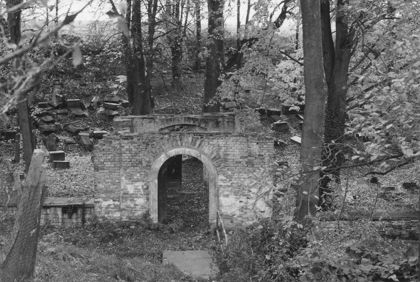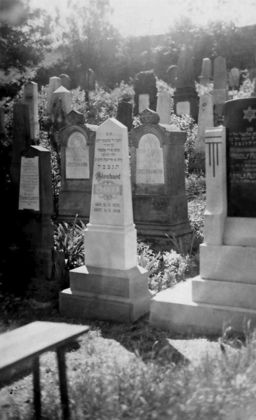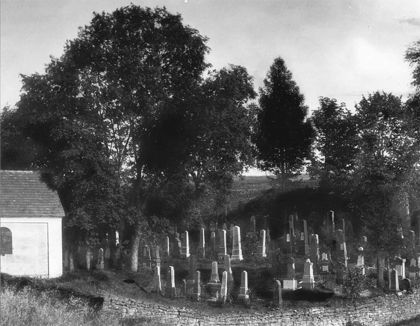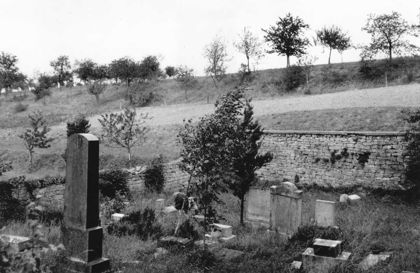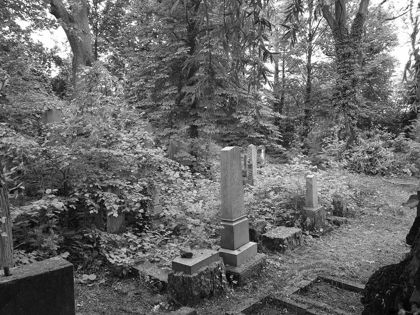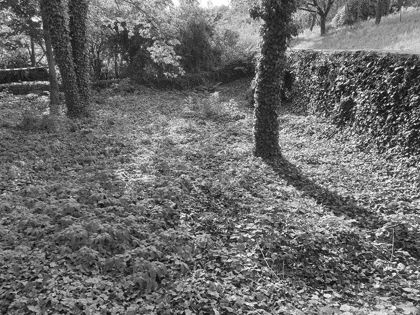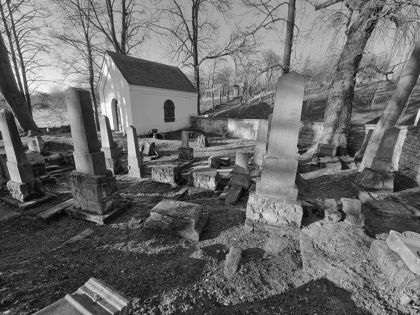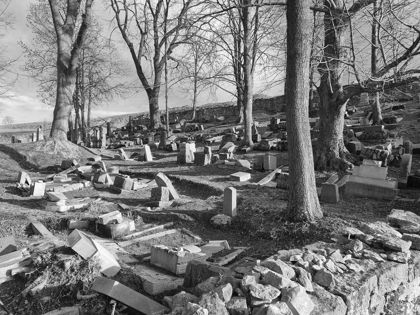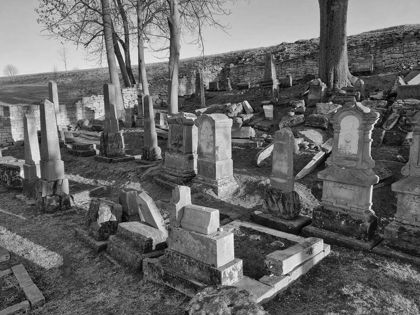Jewish Cemetery
According to Jan Heřman, the Jewish cemetery was founded in 1897. According to Vít Korec from Trutnov, though, it was founded as early as 1811 (since he writes about it in his Journey Report during his Visit to the Cemetery).
The cemetery, covering about 1454 m2, is on a moderate slope about 2 km to the north of the town centre. The headstones face north; the rows of graves go from west to east. The first burials were in the upper southern part of the cemetery with new graves being added to the north. The most recent graves are next to the brick funeral hall (which has the shape of a 3x4m rectangle), which was probably also used as an entrance to the cemetery.
The last funeral at the Jewish cemetery took place around January, 1942 (the minutes of a meeting on 15 July, 1965, dealing with the cemetery closure also include a statement made by Marta Soukupová saying that the last person buried there was her father Salamon Bohm). However, without mentioning any sources, Vít Korec writes in his Journey Report that funerals were also held there in 1944. A letter written by the local authority on 16 March, 1971, includes the following statement: "According to the results of a recent fact-finding mission, the last burial at your cemetery took place in about 1939." Mrs. Eva Dušková, née Freyová, is inclined to believe the first date, but Mrs. Emílie Králová, née Nespěchalová, remembers that she was there in the summer of 1942 at Mr. Fried's funeral.
Since WWII, the cemetery has become more and more run down, since there has not been enough money for its upkeep. Štěpán Kosek, one of the locals, wanted to take bricks from the funeral hall. He applied for permission to demolish it (the request was submitted on 12 January 1969) claiming that 'the hall is falling into ruin and, for example, the ceiling practically does not exist. Despite the fact that the Prague Jewish Community gave permission to demolish the hall (on 10 March, 1970), this demolition never actually happened.
The local stonemason, František Pilný, supposedly took away an unknown amount of stones from the cemetery in the summer of 1969. Mrs. Markéta Freyová sued him for the theft of 24 gravestones, including one which belonged to her family. The District Court in Svitavy let him off as long as he returned the stones (a ruling made on 23 January, 1970). However, this was not the end of the story. In 1972, he was charged again for the theft of another 15 gravestones. He made kerbs, stairs etc. out of them. Other people had stolen gravestones before, but only Pilný was caught out.
Closuring the cemetery was considered several times. The local authority proposed this in its letter as of 8 October, 1963 to the Jewish Community in Prague. The Community agreed, but under certain conditions. They insisted that a memorial be built at the municipal cemetery or in the urn grove, carrying the following inscription: "To the Memory of All Those Who Were Buried at the Jewish Cemetery". The reason for this was so that the survivors would not have to pay for the closure of the monument or the exhumation of the bodies, etc. The local authority refused and threatened to ask the town hygienist to order the closure of the cemetery. The chairman of the local authority also offered to buy the well-preserved gravestones for further use in sculptures. Other proposals for the cemetery's closure were submitted by the local authority in 1971 and 1974. Finally, the cemetery remained at its original location, but it was never repaired and continued to fall into ruin. On 28 December, 1986, a monument was unveiled commemorating the Jews tortured to death between 1939-1945.
Most of the gravestones at the Jewish cemetery remain in disarray to this day and some of them are damaged. Bushes and trees have grown wildly all around. In the 1980s, water got in to the cemetery from the surrounding fields, soaking the graves as well as the gravestones. It even spilled over the cemetery stone wall (we know this from a letter written on 17 April, 1989, by Mrs. Wolfová to the district authority in Svitavy).
In 2002, building work started on the cemetery's funeral hall. This work is being done by the Real Estate Administration Office of the Jewish Community which hired the MATANA a.s. Praha company to carry out the work. The Litomyšl Town Council contributed financially to the rebuilding.
Petr Tměj
Prameny: Dana Christianová, David Zeman - Židovský hřbitov v Litomyšli (seminární práce 1993/1994, Škola restaurování a konzervačních technik Litomyšl), vzpomínky pamětníků

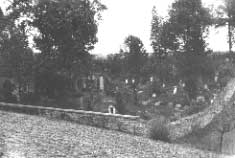
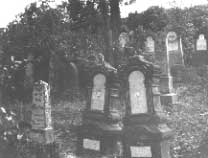
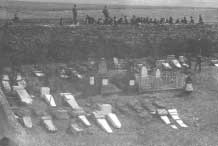
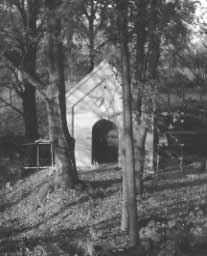
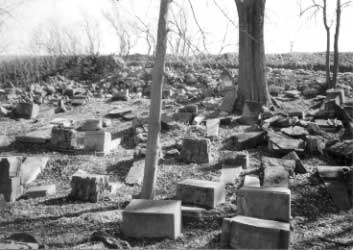
Supplemental Information about the Cemetery and Jewish Burial Traditions (June 2022)
Anglický překlad Dagmar Betty Vanek Bradac
The Litomyšl Jewish Cemetery was built in the shape of a trapezoid with the specific area of 1282 m². In January 2020, it was declared as a National Cultural Monument. Its current owner is the Jewish community in Prague. Since mid-2019, Vojtěch Toms has been volunteering as the caretaker of the cemetary.
Information about the establishment of the cemetery differs according to various sources. We consider it was established in the second half of the 19th century, namely the year 1876, because the morgue, that still stands on its extremity to this day, was built in that same year.
The main difference between Jewish and Christian cemeteries is the principle of inviolability of graves. This means that the remains of a buried person must remain forever in the same resting place as they were buried, it is not possible to open graves or move any remains.
The tombstone, embedded perpendicularly into the ground placed upon the graves of the deceased, is called a stela. It may contain various information about the deceased person, for example their professional career, family, or a description of their meritorious deeds in life. It is often expressed with sadness, and usually includes a blessing for a joyous life in the next world. It is not a rare, however, for a tombstone to bear only the name and dates of birth and death.
The epitaphs on the stelae appear in the Hebrew language, in a combination of Hebrew-German, or Hebrew-Czech. From the beginning of the 20th century, less orthodox families chose to have the inscription only in Czech or only in German.
Jews did not adorn gravestones of their loved ones with flowers, but with stones. A stone was a symbol of remembrance, and at the same time, they also believed that it would remain on the grave forever; another reason is pure practicality: In ancient times, Jews lived in the desert and buried their dead in the sand. To prevent the wind from blowing the sand away, they piled stones on top of it.
The meaning behind a few symbols on stelae
A fish - means that a person whose last name is derived from a fish is buried here: Karpeles, Fischel, Fischer.
A deer - symbolizes the family of Naftali, and also represents the names: Hirsch or Jellinek (from German), Cvi from Hebrew
Raised hands or blessing hands - here lies a priest (kohen), also represents names such as Kohn, Kahn, Katz
The star of David (the original symbol of the six-pointed star) – a symbol of Judaism, it can also express the personal name of the deceased David or Menachem
A crown - symbol of the Torah, priesthood, kingly power, or all of the above, the "the Crown of the Good Name"
A bunch of grapes, grape vine – is a symbol of Judaism of a spiritual Israel and the Promised Land, as mentioned in the Scriptures when scouts bring back huge grapes from the exploration of the Promised Land. For the same reason, we often encounter vine tendrils as a decorative symbol in synagogues, on tombstones and on the frontispieces of printed books
A palm tree - it is said that a good person grows like a palm tree - a sign of fertility, vitality
An open book – represents the entry of the deceased's name into the Book of Eternal Life; can also mean a scribe, scholar, cantor, rabbi
A Leviticus set (a set of a kettle and basin, used for the hand washing ritual of members of the priestly family) - denotes descendants of the tribe of Levites, also represents the surnames Löwy, Löw, Levy, Lewis
Jewish Burial Traditions
In Judaism, death is not an absolute end. It is a part of human life; a transition into a different form of it. It may be considered as a critical moment when a person changes their form of being. Still, death is seen as something negative. Life is sacred for Jews. Death means to leave one’s loved ones behind. At the same time, it frees one from the obligation of serving God, which from the rabbinical point of view is a reason to rejoice and the meaning of human existence.
The funeral must be arranged within 24 hours of the death, and only during the day. The only exceptions are if the funeral were to fall on Shabbat or Yom Kippur. If the burial is to take place during other holidays, it must be ensured that the grave is dug by non-Jews. A swift burial is considered respectful to the body of the deceased individual, as it decomposes with time, and therefore dishonors it.
The funeral fraternity (Chevra kadiša) oversees the preparation the funeral and the funeral rites. Preparing the body of the deceased is considered an honor, a selfless and noble act from which no person may benefit.
Funerary Rituals
An individual close to death must not be abandoned. It is a duty to stand by as one’s soul as it departs. At such a moment, those present say one of the most important Jewish prayers, the Shema Yisrael. To ensure that a death has truly occurred, down feathers are placed under the nostrils of the deceased for a period of 8 to 10 minutes.
The dead are treated with the same dignity and respect as the living. The body is allowed to rest for 15 minutes. Then the eyes of the deceased are pressed, and the arms are ‘blessed’ with the Lord's name Shaddai. In the next 15 minutes, the body is placed on the ground with the feet facing the door, the mouth is covered with a scarf, the toes are tied with thread, and the whole body is covered with a sheet. A candle or an oil lamp is placed near the head of the deceased as a sign of respect for the soul leaving the body.
First, the deceased must be prepared for burial according to strict religious regulations, as if the individual were going to a formal event. The body should be washed and dressed, hair combed, and the nails cleaned and trimmed. It is ethical that a man is washed by a man and a woman by a woman. Warm water is used for bathing and the body must never be exposed more than absolutely necessary. This phase is accompanied by a prayer composed of biblical verses.
The dead body is then dressed in a white linen shroud. Judaism dictates that any difference between the rich and the poor must not be apparent; therefor, all those buried are dressed in the same clothing. For this same reason, the boards of the coffin are not planed.
The preparation process is called tahara.
Before the ceremony, close relatives make a tear in their clothes as an expression of grief, which is an old custom originating from the Orient.
Ciduk ha-din, translates to "justification of judgment", is the first part of the funeral. After the prayer of recognition of God's justice and reconciliation with his judgment, the funeral oration follows. It is recited by a rabbi; in which the good deeds of the deceased are described.
Subsequently, the procession lines up and accompanies the coffin with the deceased, carrier on a bier, to the prepared grave.
As the casket is lowered into the grave, each person present throws three shovelfuls of earth on it as a symbol of respect for the deceased child of Israel.
No jewelry or valuables are placed in the grave. The deceased are buried only with what is a part of the body or what has become a part of the body, such as a prosthesis. On the other hand, anything that leaves the body at the moment of death must also buried with the body. For example, in the case of bleeding, the blood must be buried in a special container with the deceased in the coffin. If a person dies a violent death, it is necessary to bury them with the blood-soaked earth and in the clothes in which they were killed. (In this case, the body would not be dressed in a shroud. The ritual practice claims that a murdered person must appear before God for judgment with everything, including the clothes, so that the punishment of the culprit be more severe.)
The last stage of the ceremony takes place in the synagogue, exceptionally at the gravesite. The participants first pray together, then one of the male relatives recites the Kaddish. The Kaddish is not a prayer in the true sense of the word, i.e. it is a plea for the peace of the soul of the deceased. It is not about death, but about the glory and divinity of God.
While leaving the grave or the synagogue, all participants of the funeral ritually wash their hands. Tradition dictates that friends invite the funeral attendees to a consolation feast.
An ideal source of information for those interested in this topic:
Jaroslav Achab Haidler: Jewish cemeteries and burials The author is currently one of the biggest experts on Jewish cemeteries in our country. You can also read his work at www.chewra.com
Works cited:
HAIDLER, Jaroslav Achab. Židovské hřbitovy a pohřbívání. Praha: Grada, 2019. ISBN: 978-80-271-0261-7
POUCHLÁ, Martina. Tradiční židovský pohřeb je spojený s trháním oděvu i vyléváním vody. In: Temata.rozhlas.cz [online]. 12.4.2016 [cit. 16.05.2022]. Dostupné z: https://temata.rozhlas.cz/tradicni-zidovsky-pohreb-je-spojeny-s-trhanim-odevu-i-vylevanim-vody-7992063
REIFOVÁ, Gabriela. Pohřbívání v židovské kultuře jako souhrn sociálně-náboženských funkcí a jejich proměna v čase. In: kulturnistudia.cz [online]. 2.2015 [cit. 16.05.2022]. Dostupné z: https://kulturnistudia.cz/pohrbivani-v-zidovske-kulture-jako-souhrn-socialne-nabozenskych-funkci-a-jejich-promena-v-case/
SVOBODA, Lukáš. Symbolika židovských náhrobků. In: kvmuz.cz [online]. [cit. 16.05.2022]. Dostupné z: http://kvmuz.cz/typ/zidovske-hrbitovy/symbolika-zidovskych-nahrobku
VODVÁŘKA, Tomáš. Symboly na židovských náhrobcích. In: vodvarka.blog.idnes.cz [online]. 11.8.2016 [cit. 16.05.2022]. Dostupné z: https://vodvarka.blog.idnes.cz/blog.aspx?c=542594
Průvodce brněnským židovským hřbitovem. In: zob.cz [online]. 10.2016 [cit. 16.05.2022]. Dostupné z: https://www.zob.cz/wp-content/uploads/2016/10/pruvodce_hrbitovem_cz_symbolika_web.pdf

